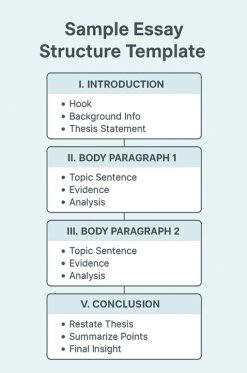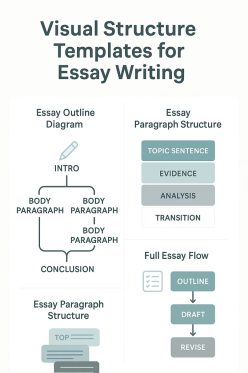Table of Contents
Writing a well-structured essay is essential in academic writing. Whether you’re new to essays or want to improve your academic writing essay structure, understanding the basic structure of an essay helps convey your ideas clearly. This guide covers everything—from the introduction, body, and conclusion to different essay structure types used in academic contexts.
The structure of an essay refers to the logical arrangement of its parts: introduction, body, and conclusion. A proper essay writing structure supports your thesis, flows smoothly between points, and meets academic expectations.
Also, if you’re unsure about how much content each section should include, check out our guide on the ideal essay length to align your structure with academic standards.
Start your essay structure format with a strong hook, offer background, and present a concise thesis statement.
Example Thesis: “Although online education increases accessibility, its effectiveness depends on strategic implementation and learner support.”
Explore more tips in our How to Write an Essay Introduction guide.
The essay body structure organizes arguments logically. Each paragraph should include:
Use our Essay Writing Tips for building cohesive body paragraphs.
Wrap up your introduction body conclusion essay structure by:
Example Conclusion: “In summary, while online learning enhances accessibility, educational institutions must ensure structure and engagement for optimal outcomes.”
Dive deeper into conclusions with How to Write a Conclusion for an Essay.
Although the basic essay structure—introduction, body, and conclusion—applies across most academic writing, the way you organize content within that structure depends on the type of essay you’re writing. Below are three widely used academic essay formats that demonstrate how the structure of an essay can adapt depending on the writing style and purpose.
The essay body structure for an argumentative essay emphasizes logical reasoning and evidence-based claims. Your goal is to persuade the reader using well-structured paragraphs and clear transitions.
Structure:
Related Resource: Need help with organizing claims? Explore our Argumentative Essay Writing Service for expert assistance.
In a descriptive essay, the structure is used to arrange sensory impressions and vivid imagery logically, usually organized around theme or sequence rather than strict logic.
Structure:
Looking for topic ideas? Explore our curated Descriptive Essay Topics to get started.
Expository essays follow a very clear and factual essay structure format. Their purpose is to explain or clarify a topic using definitions, statistics, and evidence—not opinions.
Structure:
Not sure what topic to start with? Browse these essay topics ideas to find relevant and structured prompts for expository writing.
To write a well-organized academic essay, it’s essential to follow a consistent and logical essay structure format. Below is a sample essay structure template that illustrates how to organize each part of an essay clearly. Use this as a guide when planning your essay outline or drafting each section. This template supports the classic introduction–body–conclusion model and reflects the foundational structure of an essay.

To meet academic standards, use the following essay format:
| Formatting Element | Requirement |
|---|---|
| Font | 12 pt Times New Roman |
| Line Spacing | Double-spaced |
| Margins | 1 inch on all sides |
| Paragraphs | Indent the first line |
| Headings | Use only if specified |
For detailed formatting rules, check our How to Format an Essay guide.
Word Count Guidelines:
Missing Thesis
Unfocused Paragraphs
Weak Transitions
Understanding the essay structure format becomes much easier when you can see how each part fits together. If you’re starting from scratch, use our Essay Outline Guide to create a clear foundation before you begin writing. Visual essay templates support this process by helping you organize an essay from outline to final draft—ensuring logical flow, structural consistency, and clarity throughout your essay.
A well-structured essay isn’t just about words; it’s about how ideas are grouped, sequenced, and connected. By using visual templates, you can map out the introduction, body, and conclusion essay structure with ease, reducing the chances of missing important transitions or duplicating points.
These templates are especially helpful for students learning how to build a proper essay structure—they visually connect each section, from hook to final insight. They also work well for peer review and editing sessions, helping others evaluate the clarity of your essay writing structure.

These diagrams complement any essay style—from argumentative to expository—and ensure you’re always working with a strong foundation.
A well-organized essay reflects thoughtful preparation. Understanding the parts of an essay and mastering the components of essay structure helps you communicate effectively and meet academic expectations. Begin with an outline and use this guide to build a strong, cohesive essay.
Need help? Use our write my essay for me service to receive personalized structure support from experts.
Q1. What is the correct essay structure?
Ans: A standard essay includes an introduction, body, and conclusion. Each plays a unique role in presenting and supporting your argument.
Q2. What does academic essay structure mean?
Ans: It’s a format that ensures clarity, coherence, and proper flow, often including a thesis and transitions.
Q3. Can I use headings in an essay?
Ans: Generally, headings are not used in traditional academic essays unless specified, such as in reports.
Q4. What is the essay body structure?
Ans: The body structure refers to paragraphs that each present one main point, supported by evidence.
Q5. How many paragraphs should my essay have?
Ans: This depends on the essay’s length, but 5–7 paragraphs is a common standard.
Q6. What is the introduction-body-conclusion format?
Ans: It’s a logical layout: the introduction hooks the reader, the body develops ideas, and the conclusion wraps it up.
Q7. How do I organize my essay effectively?
Ans: Start with an outline, use topic sentences and transitions, and always connect ideas back to your thesis.
Q8. Are there different essay formatting styles?
Ans: Yes—MLA, APA, and Chicago styles dictate how to cite sources and format your paper.
Q9. How do I maintain structure in long essays?
Ans: Use subheadings (if allowed), clear transitions, and strong paragraph planning.
Q10. What can I do if my essay lacks flow?
Ans: Revise for coherence by improving transitions and simplifying complex or overly long paragraphs.